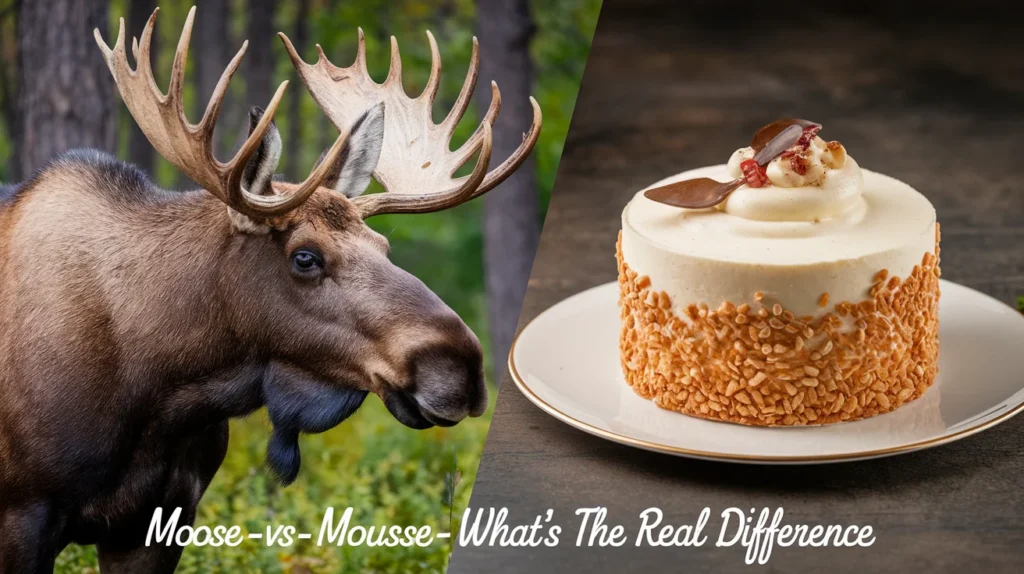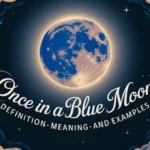Have you ever found yourself wondering if moose is just a typo for mousse or vice versa? You’re not alone! While the words sound almost identical, they couldn’t be more different.
One is a majestic animal, roaming the forests of North America and Northern Europe, while the other is a delectable dessert often served at fancy dinner parties or as a sweet treat at home. This article will help you untangle the confusion between these two terms once and for all.
From their spelling to their meaning, and even how they’re used in everyday conversations, this guide will take you on a journey to understand the key differences.
Whether you’re looking to avoid embarrassment in conversation, correct a mistake on a menu, or simply satisfy your curiosity, we’ve got you covered.
By the end of this post, you’ll know exactly how to use these words correctly, and you’ll also learn a little something about both the animal and the dessert!
What Is a Moose?
Let’s start with the animal that often gets mistaken for a dessert—the moose. The moose (scientific name: Alces alces) is a large, impressive creature native to the forests of North America, Northern Europe, and Asia.
They are the largest members of the deer family and are known for their massive size and distinctive features, such as their long legs, large hooves, and broad, palmate antlers (which can span up to 6 feet across!).
Physical Features of a Moose
- Size: Adult male moose, also known as bulls, can weigh between 900 and 1,500 pounds, while females are generally smaller.
- Antlers: Only male moose grow antlers, which are shed annually in winter.
- Color: Moose generally have dark brown fur, which helps them blend into their forest environments.
- Diet: They are herbivores, feeding on leaves, twigs, bark, and aquatic plants.
Moose Habitat and Geographic Range
Moose are commonly found in forests and wetlands, where they can find food and shelter. In North America, you can spot them in places like Alaska, the Northeastern U.S., and Canada. In Europe and Asia, they roam the forests of countries like Sweden, Russia, and Finland. These creatures are known for their solitary behavior, although they do sometimes form small groups during the winter months when food is scarce.
Moose Behavior and Fun Facts
- Swimming: Moose are excellent swimmers and can dive as deep as 20 feet underwater to forage for plants.
- Mating season: During the rutting season, males engage in dramatic displays of strength, calling out to attract females.
- Speed: Despite their size, moose can run at speeds of up to 35 miles per hour and can maintain this pace for a short distance.
While they may seem intimidating due to their size, moose are generally peaceful creatures unless provoked. They play a significant role in their ecosystems by maintaining the balance of the plant life they feed on, which in turn supports other wildlife species.
What Is Mousse?
Now that we’ve covered the majestic moose, let’s turn our attention to mousse, the airy, creamy dessert often mistaken for the wild animal.
Definition of Mousse
Mousse is a French word that translates to “foam”, and it’s used to describe a type of dessert (or even a savory dish) that is light, fluffy, and whipped to perfection.
It’s made by folding whipped cream or egg whites into a rich base, which can include ingredients like chocolate, fruit puree, or savory items like fish or vegetables.
Types of Mousse
- Chocolate Mousse: A classic favorite, made by combining rich chocolate with whipped cream to create a smooth, velvety texture.
- Fruit Mousse: Mousse can also be made using fresh fruit puree, such as strawberries, mangoes, or lemons, providing a refreshing twist to the traditional dessert.
- Savory Mousse: Although less common, savory mousses made from ingredients like salmon, vegetables, or cheese are also enjoyed in fine dining.
Key Ingredients and Texture
The main components of a mousse are:
- Heavy cream or whipped egg whites to achieve the light, fluffy texture
- Chocolate, fruit, or savory ingredients for flavor
- Gelatin or whipped cream to help the mousse set
The texture is what truly sets mousse apart from other desserts like pudding or custard. It’s light, airy, and melts in your mouth, which is why it’s such a favorite in upscale restaurants and homes alike.
Moose vs. Mousse: Quick Comparison Table
| Feature | Moose | Mousse |
| Category | Animal (mammal) | Food (dessert or savory dish) |
| Pronunciation | /muːs/ | /muːs/ |
| Plural Form | Moose (same) | Mousses |
| Common Confusion | Sounds the same as “mousse” | Sounds the same as “moose” |
| Context Example | “A moose crossed the road.” | “This chocolate mousse is delicious.” |
Why People Get Moose and Mousse Confused
It’s easy to see why so many people mix up moose and mousse. Not only do they sound the same, but they’re also spelled similarly.
The only difference is a single letter: the e at the end of “mousse”. This minor distinction can easily be overlooked when reading or writing quickly, which is why both words often get interchanged in conversations, menus, and even text messages.
Spelling Errors
One of the most common errors is writing moose when referring to the dessert, or vice versa. In some cases, autocorrect can even play a part, especially if you’re typing “mousse” on your phone but accidentally get “moose” in its place.
Cultural References
The confusion is also perpetuated by how the two words pop up in cultural references. For instance, there’s a popular cartoon featuring “Rocky and Bullwinkle,” with a character named “Bullwinkle the Moose,” yet there’s also chocolate mousse in dessert menus. These connections make it even easier to get the two mixed up.
How to Remember the Difference
So, how do you remember which is which? There are a few simple tricks you can use:
- Moose = Antlers
When you think of a moose, picture its massive antlers. If you’re referring to an animal, you’re talking about a moose. - Mousse = Spoon
On the other hand, when you think of mousse, think of a dessert that’s typically eaten with a spoon. It’s light, fluffy, and creamy—perfect for spoonfuls of deliciousness! - Visual Aid
Consider creating a mental image of the two. Picture a moose in the wild and a bowl of mousse on a fancy dessert tray. The contrast will help you keep the two distinct.
Moose in Culture and Language
Beyond its biological characteristics, the moose has played an important role in cultural lore and language.
Moose as a Symbol
In places like Canada and Scandinavia, the moose is not just an animal; it’s also a national symbol. Canada, for example, has adopted the moose as a symbol of strength, freedom, and wild beauty. In fact, you’ll see this majestic animal featured prominently on souvenirs, coins, and tourism campaigns.
Pop Culture References
Moose are often used in pop culture for their distinctive look. Who could forget the beloved cartoon character Bullwinkle, the talking moose, in the 1950s animated show The Rocky and Bullwinkle Show? The moose is often portrayed as a gentle giant with a comedic charm.
Mousse in Culinary Culture
Let’s shift focus back to mousse. This dessert has an extensive history and is loved by many for its rich and delicate flavor profile.
Famous Mousse Recipes
The most famous variety of mousse is chocolate mousse. It’s a staple in French cuisine and is often served at fancy dinners or on special occasions.
Other variations, such as fruit mousse, are also popular, offering a refreshing alternative to the heavier chocolate version.
Mousse vs. Other Desserts
While mousse is light and fluffy, it’s often compared to desserts like pudding, custard, and soufflé. However, mousse has a lighter texture due to the whipped cream or egg whites, making it more airy than its heavier counterparts.
Summary: Key Takeaways
- Moose is a large, wild animal, while mousse is a creamy dessert (often chocolate or fruit-flavored).
- Both words sound identical, but their meanings are worlds apart.
- Moose can be found in forests and wetlands, while mousse is typically served at dinner parties or restaurants.
- Remember the mnemonic: moose = antlers, and mousse = spoon!
FAQs (Frequently Asked Questions)
1. What is the difference between a moose and mousse?
A moose is a large mammal native to North America, Europe, and Asia, known for its massive size and antlers. On the other hand, mousse is a type of light, fluffy dessert, often made with whipped cream, egg whites, and chocolate or fruit flavors. Despite their similar pronunciation, one refers to an animal, while the other is a delicious treat.
2. Can mousse be savory?
Yes! While most mousses are sweet, typically made with chocolate or fruit, savory varieties also exist. For example, salmon mousse and vegetable mousse are popular in some gourmet cuisines, offering a different and flavorful twist on the classic dessert.
3. Why do people confuse moose and mousse?
The confusion arises because moose and mousse sound the same and are spelled similarly, with only a single letter difference. Additionally, both terms are used frequently in popular culture, food menus, and casual conversation, making it easy to mix them up, especially when reading or writing quickly.
4. What is the plural of moose?
The plural form of moose is simply moose. This is an example of a noun that does not change when referring to more than one. For example, you would say, “We saw three moose in the forest,” rather than “mooses.”
5. Can you eat moose meat?
Yes, moose meat is edible and is considered a delicacy in certain regions, particularly in Northern Europe and North America. It is lean, nutritious, and often used in various dishes like stews, sausages, or steaks.
Conclusion
To wrap things up, remember that moose and mousse may sound the same, but they belong to entirely different worlds—one in the wild and one in the kitchen! With this knowledge, you’ll never confuse the giant animal with the delicious dessert again. Whether you’re spotting a moose in the forest or indulging in a chocolate mousse after dinner, you now have a clear understanding of each term and its true meaning.

Isabella Sofia is a passionate writer and spiritual enthusiast dedicated to exploring the profound meanings behind angel numbers. With a deep belief in the guidance of the universe, Isabella shares her insights and interpretations to help others connect with their spiritual journey.



